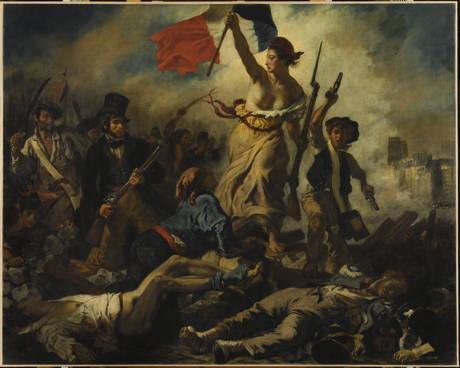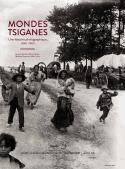Art Of The Day Weekly
#508 - from 29 March 2018 to 4 April 2018

Eugène Delacroix, 28 July 1830. The Liberty leading the people, 1830, oil on canvas. 260 x 325 cm. Musée du Louvre © RMN-Grand Palais (musée du Louvre) / Michel Urtado.
IN THE AIR
Delacroix, an assessment
PARIS - When Sébastien Allard, the curator for paintings at the Louvre -and one of the two commissioners - presented the exhibition, he had anticipated a potential response from the public. Indeed, a “Delacroix, again?” would not have been surprising, given the number of times the leader of the Romanticism has been seen over and over again. The ones responsible for that are the former F100 bill, and his Liberty leading the people. Actually, it has been over fifty years since such an impressive group of works has been presented in Paris. That last time was exactly in 1963, when the accumulation was spectacular – some 700 works of art. This time there are just 200 and some of them did not need to travel far, as the Louvre owns the number one collection in the world. Nevertheless, there are some beautiful loans from abroad – Basel, Berlin, Houston, Mexico, Prague, Rotterdam, Washington, among others – and the offer goes from drawings of youth to surprising floral compositions from his older years, up to the dismal failure at the Salon in 1859. In an alcove in the middle of the exhibition, volumes of the Journal, an inordinate enterprise Delacroix carried out for over fifteen years, from 1847 to 1863, demonstrate the terribly versatile talent and the constant doubts of the artist who was the rival – and from all points of view – the exact contrary of Ingres.
• Delacroix (1798-1863) at the Louvre, from 29 March to 23 July 2018.
Hazan catalogue.
EXHIBITIONS
Ready to love all that is Japanese
GIVERNY – In order to be ready for the Japanese tide we are meant to face this year, aimed at celebrating the anniversary of diplomatic relations between France and Japan (1858), and the opening of the country to the rest of the world (1868), we need a few keys. This exhibition, that is meant to travel to Germany later, gives a certain number by starting from the Impressionist galaxy, the first one to have a real crush on Japanese objects, starting with hand fans, kimonos, paper lanterns, among other things. Major themes, such as geishas, collector painters, or prints allow us to approach the subject in a transversal manner by calling together artists as different from one another as Toulouse-Lautrec, Gauguin, Vallotton, Vuillard or Rivière (the author of 36 Views of the Eiffel tower, a concealed echo to those of Mount Fuji).
• Japonismes/Impressionnismes at the Musée des Impressionnismes, from 30 March to 15 July 2018. Gallimard catalogue.
Suez, a lasting myth
PARIS –The title tells it all: the Suez Canal, inaugurated in 1869, was a true epic. An engineering epic – the glory of Ferdinand de Lesseps – as can be seen in the models of the new towns (Ismailia and Port-Said) or the old photographs that render immortal the giant dredges with spillways. But it was a political epic as well: when Nasser decided to win his hand against the Western nations and capitalism, in 1956, he did it by nationalizing the canal. It was an economic epic as well: the enlargement entailed works worthy of a Pharaoh, carried out at an accelerated pace, and allowed for a doubled canal to be inaugurated in August 2015. This put an end to the alternative circulation and reduced the average traveling time. In the long term, Egypt should increase its revenue up to $10 billion annually. Paintings, letters, posters, ex-voto and films (from Lawrence of Arabia to OSS 117) bring back a lasting myth.
• L’épopée du canal de Suez at the Institut du monde arabe, from 28 March to 5 August 2018. Gallimard catalogue.
The unknown Merlini
VENICE – Can one be semi-anonymous and build a quality collection of the greatest names of the 20th century? This seems impossible today given how important the sums involved are. Those who on the contrary, started in the sixties and patiently wove their web, the answer is positive. It seems to be what Giuseppe Merlini has demonstrated. He was unknown by the public at large, born in 1932 at Busto Arsizio, in the suburbs of Milano, where he held a large accounting firm. In 2015 he created a foundation with his name, in charge of promoting training, culture and innovation for young people. But what is most remarkable about him is his collection of nearly 400 pieces of Italian art. It covers a large part of the Novecento, including works by Melotti, Savinio, Fontana, Burri, Baj, Morlotti, and did not mind putting aside the more mediatized currents, such as Pop Art or Arte Povera. A selection is presented in the enchanting and decadent venue of the Palazzo Fortuny, an emblematic site for these private passions since it housed the designer’s superb private collection.
• Una collezione italiana. Opera dalla collezione Merlini at Palazzo Fortuny, from 24 March to 23 July 2018.
BOOKS
The lens is on Gypsies
Gypsies have been good clients for photographs used for forensic identification. Care was always taken so their anthropomorphic data (including “simultaneous print of all fingers together, and not rolled one after another”), and their police records, were up to date. But informers were not the only ones interested in them. Their energy, their freedom, their music fascinated persons like prince Roland Bonaparte, the young Swiss historian Friedel Bohny Reiter, who documented their community in the prison camp of Rivesaltes in 1943, or well-known photographers such as François Kollar, Erwin Blumenfeld, Roger Schall or Denise Bellon. This book, that accompanies an exhibition at the Musée national de l’histoire de l’immigration (National Museum on the History of Immigration) in Paris and covers a century of representation, underlining a few specific individuals, such as Emile Savitry, a friend of Django Reinhardt’s, Jacques Léonard, and writer, pastor, ethnographer and photo-reporter Matéo Maximoff. Mathieu Pernot, who followed the destiny of the Gorgan family of Arles for twenty years, gives a few keys on the reports photography makes of the Gypsy universe.
• Mondes tsiganes, directed by Ilsen About, Mathieu Pernot, and Adèle Sutre, Actes Sud, 2018, 192 p., €29.
OPENINGS OF THE WEEK

OLIVIER REBUFA
31 March 2018 - MONTPELLIER - Galerie Annie Gabrielli
When the artist, thanks to his intimate knowledge of Africa, turns into a shaman


